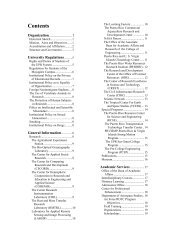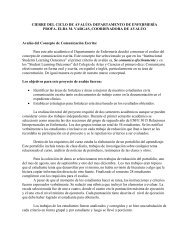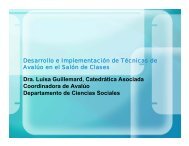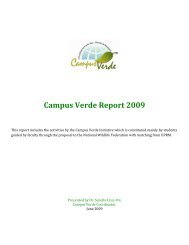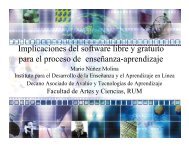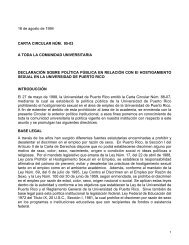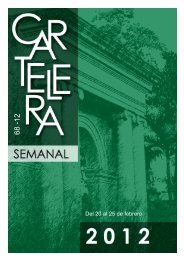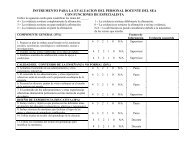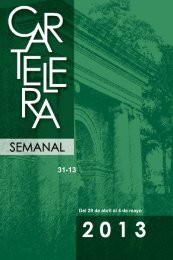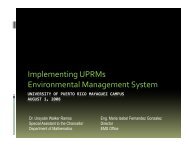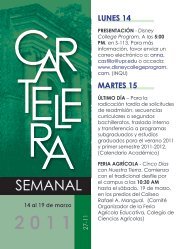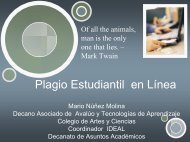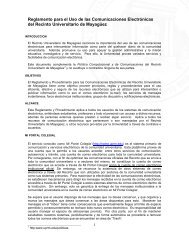Undergraduate Catalogue - UPRM
Undergraduate Catalogue - UPRM
Undergraduate Catalogue - UPRM
Create successful ePaper yourself
Turn your PDF publications into a flip-book with our unique Google optimized e-Paper software.
Research<br />
PRSN also operates a tsunami warning system<br />
monitoring seismic and tsunami events in Puerto<br />
Rico the Caribbean and adjoining regions.<br />
Geological and Environmental Remote<br />
Sensing Laboratory (GERS Lab)<br />
GERS Lab was founded in January 2002 as part<br />
of the Department of Geology in the University<br />
of Puerto Rico at Mayagüez. Our mission is to<br />
promote and facilitate the education and research<br />
of the Earth System Science using remote<br />
sensing. Current research is mainly focused on<br />
environmental monitoring with bio-optical<br />
properties and digital images. We are also<br />
interested in developing Geographic Information<br />
Systems. Our vision is to become a prestigious<br />
laboratory in remote sensing of the Caribbean by<br />
generating innovative research and producing<br />
Earth System scientists well trained in the<br />
application of these tools. We conduct image<br />
processing and analyses of several sensors,<br />
including SeaWiFS, AVHRR, MODIS, ETM +,<br />
SAR, IKONOS, and Hyperion. Our research<br />
facilities include an image processing laboratory<br />
equipped with three Dell personal computers,<br />
two Silicon Graphics, scanners, a plotter, and<br />
color printers. We also have teaching facilities<br />
with twenty personal computers, scanners, and<br />
printers. ENVI and ArcGIS software are<br />
available in all our research and teaching<br />
computers.<br />
Tropical Center for Earth and Space Studies<br />
TCESS is funded by NASA’s University<br />
Research Centers (URC) Program. It is divided<br />
administratively into five components:<br />
1. Space Information Laboratory (SIL)<br />
2. Earth Systems Studies (ESS)<br />
3. Advanced Automated Image Analysis<br />
(AAIA) for Remotely Sensed Data<br />
4. Sensor Materials and Electronics for<br />
Space Applications (SMESA)<br />
5. Outreach and Education<br />
university researchers. SIL is a training center<br />
for scientists and engineers in a bilingual<br />
environment. The Laboratory provides<br />
opportunities for research applicable to the<br />
problems of the Caribbean area. The Earth<br />
Systems Studies component contains two<br />
working groups who have participated in other<br />
NASA programs. The Geology Group<br />
investigates surface deformations and hazards of<br />
Lesser Antilles island arc volcanoes. The<br />
Marine Sciences Group investigates the effects<br />
of the thinning of the ozone layer and related<br />
surface UV radiation modulation on the<br />
development of plant screening pigments.<br />
The Advanced Analysis Information Systems<br />
Group from Electrical and Computer<br />
Engineering investigates new image-processing<br />
algorithms and techniques for storage,<br />
processing, and dissemination of remotelysensed<br />
data using high-speed streams with<br />
implications for SAR processing.<br />
The Sensor Materials and Electronics for Space<br />
Applications component investigate a number of<br />
materials with special properties suitable for<br />
space sensors. Techniques and materials for<br />
power conversion electronics for spacecraft are<br />
also studied.<br />
An Outreach and Education component works<br />
along with TCESS. An extension of the<br />
successful "Science on Wheels" project, a<br />
"Space Communications on Wheels" van brings<br />
space and earth studies to high school students in<br />
Puerto Rico. A Technology Transfer Internship<br />
Program is being developed that will allow<br />
professors and students to visit U. S. National<br />
Laboratories, universities, and NASA field<br />
centers to facilitate technology transfer and<br />
encourage advanced studies.<br />
The Space Information Laboratory<br />
Built on the foundations of LARSIP, it is funded<br />
by contributions from NASA, UPR, and<br />
Fomento (Commonwealth Economic<br />
Development) <strong>UPRM</strong> installed and operates<br />
Synthetic Aperture Radar (SAR) and HRPT<br />
tracking stations. These are national facilities<br />
available by invitation to other NASA and US<br />
<strong>Undergraduate</strong> <strong>Catalogue</strong> 2008-2009 19



